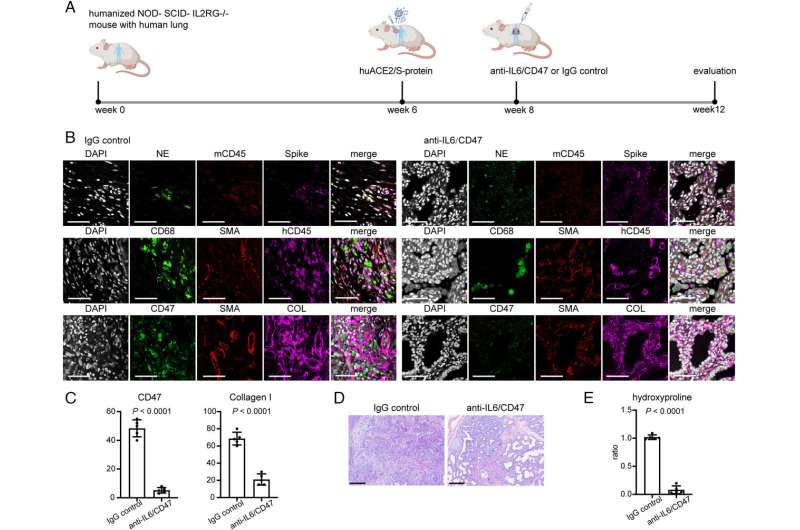This article has been reviewed according to Science X's editorial process and policies. Editors have highlighted the following attributes while ensuring the content's credibility:
fact-checked
peer-reviewed publication
trusted source
proofread
Runaway immune reactions can cause long COVID breathing problems

Stanford Medicine researchers have found a mechanism behind one of the most common symptoms of long COVID—shortness of breath. Post COVID-19 breathing problems are caused by a condition known as lung fibrosis, when damaged lungs form scar tissue, which makes it difficult for lungs to expand and contract.
Long COVID cases can be severely debilitating and resistant to treatment, said Gerlinde Wernig, MD, Ph.D., assistant professor of pathology, who led the study. What's worse, lung function can continue to decline, even without a new COVID-19 infection. The team's new research, published in the Proceedings of the National Academy of Sciences, pinpoints what's happening in the lungs to cause fibrosis: overactivity of genes that regulate inflammation and immune responses.
The finding offers hope that, one day, targeted drugs could intervene to quell the genes behind the damage, something they're already testing out in mouse studies, Wernig said.
"This was an extension of our work with chronic pulmonary fibrosis," said Wernig. Previously, Wernig and her colleagues conducted research showing that the dysregulation of particular immune processes caused fibrosis in the lungs. Wernig wondered if something similar was happening in the lungs of people with long COVID.
Tracking patterns
The team started by looking at lung tissue samples from five COVID-19 patients who had had symptoms of the disease—such as shortness of breath—for one or more months. The lungs of people who had symptoms after infection with SARS-CoV-2 (the virus that causes COVID-19) looked like the lungs of people with end-stage pulmonary fibrosis, said Wernig.
By analyzing single cells from the patients' tissue samples, the scientists also saw similarities in the pattern of RNA production—which can hint a cell's overall function—between samples of tissue from long COVID patients and samples from patients with pulmonary fibrosis.
"We saw this same pattern across all human COVID lung samples," Wernig said. As with other lung infections, the initial COVID-19 infection in the lungs kicked off an inflammatory process. In the case of long-COVID patients, however, the immune dysfunction keeps going long after the virus is gone—similar to what happens in chronic pulmonary fibrosis.
In her previous research, Wernig showed that pulmonary fibrosis was characterized by a spike in the production of an inflammatory marker called interleukin-6 in the lungs, which is associated with chronic inflammation and scar formation. Furthermore, in pulmonary fibrosis, scar-forming cells called fibroblasts increase production of a protein called CD47, which stops the immune system from keeping fibroblasts under control, meaning scar tissue forms unchecked. The researchers also saw increases in a protein called pJUN, which is a key promoter of scar formation.
To test whether lung fibrosis could be firmly connected to COVID-19 infections, they looked at lung fibrosis in mice infected with a SARS-CoV-2-like virus and found significant increases in fibrosis and immune disfunction. "Innate immune cells go crazy after that infection," Wernig said, referring to the part of the immune system that forms the first line of defense against pathogens.
In a mouse model engineered to more closely represent human biology, researchers showed that, when the mice contracted SARS-CoV-2, scarring in the lung tissues shot up, as did levels of interleukin-6, CD47 and pJUN. There was also a bright side to these experiments. "When we did the same experiments but blocked CD47 and Il-6, we saw very little fibrosis," Wernig said. "This hints at possible treatments for long COVID involving drugs that carry out targeted immune blockades."
More information: Lu Cui et al, Innate immune cell activation causes lung fibrosis in a humanized model of long COVID, Proceedings of the National Academy of Sciences (2023). DOI: 10.1073/pnas.2217199120

















